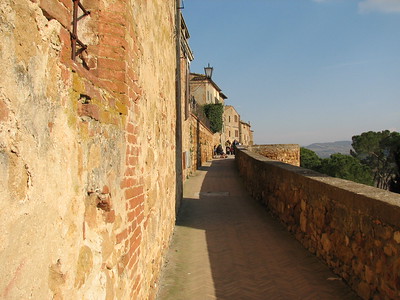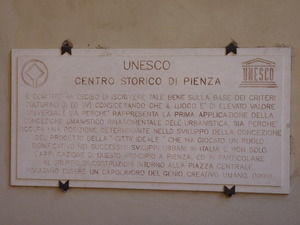Pienza

The Historic Centre of the City of Pienza is the earliest example of a Renaissance "ideal town".
It was created by Pope Pius II, a humanist who decided to refurbish his poor hometown of Corsignano and turn it into his papal summer court. The buildings and objects designed by Bernardo Rossellino are a blend of the Renaissance and the German Gothic style. Also, the technique of sgraffito was used all over town.
Community Perspective: To most of us, it’s a lovely little town with a homogenous townscape. You have to be a student of architectural history to fully appreciate the Humanist Renaissance influence in its design.

Map of Pienza
Community Reviews
Bropyk

Pienza - a beautiful little town, where there weren't really many tourists. It was quiet there and when I looked at something for a longer time, no one pushed me. In my opinion, there is a Renaissance feel here more than in other Tuscan towns. Definitely don't miss sitting or at least standing for a while on the castle walls and looking at the countryside. There is a beautiful view of a piece of Tuscany and other towns on the hills. Then all you have to do is go somewhere for a good meal or at least a dessert. Suddenly you don't want to do anything, just stop and do nothing.
James Bowyer

Having sworn off guided coach tours after a poor experience in Poland, I somehow had lapse in judgement and ended up booking myself on one from Rome up to Tuscany for the day. I thought, how bad could it be? In all honesty, not too bad at all although the day was clearly aimed at tourists looking to experience some Tuscan cuisine and culture rather than appreciate some Outstanding Universal Value and obsessively tick off another site on a somewhat arbitrary list. As such, we spent 1.5 hours in Montepulciano, which is a delightful village but tantalising just outside the core zone of Val d’Orcia, then 1.5 hours at lunch, which again was lovely although I would have liked larger portions, and finally just 30 minutes in Pienza itself. Admittedly, it is possible to see pretty much everything there is in Pienza in that time but I would like to have been a little less rushed.
Whilst the morning in Montepulciano had been too foggy to admire the view, from the terrace on the south side of Pienza by the afternoon the weather had cleared and there was a great view across the valley below with its iconic cypress trees and rolling hills. There is only one main road and you can walk across the whole town in no time at all but the all the little side alleys were a pleasure to explore, however briefly, with hidden tiny piazzas. On the main square, Palazzo Piccolomini is free to look in and see the cats lounging in the courtyard but a ticket is required to go inside the building for which I did not have time. The church is intriguing as it looks like any other Italian Renaissance church on the outside, which is no bad thing, whilst the inside is in a totally unexpected Gothic style (see picture attached). Were it not for the obviously Catholic paintings and surfeit of marble, I would easily mistake it for a church back home in England. Apparently, the design was inspired by Pope Pius II’s travels in Germany. Had this remained simple Corsignano, it would be no different to any other of the hundreds of picture-perfect villages dotted throughout Italy. The return of local boy Enea Piccolomini, who would go on to become Pius II, created this charming small Renaissance town that is certainly worth visiting. Our tour group seemed to be the only tourists there although this was in mid-November so your mileage may vary. Nevertheless, one of the finest towns in a country where every town might be inscription worthy if it were transplanted elsewhere in the world.
Matejicek

Pienza is pretty. Pienza is very little. Pienza is WHS with OUV that is rather philosophical, I would say. Pienza is located on a hill, so, there are beautiful views on the Orcia valley (another WHS) and towards Monte Amiata (photo), which is also worth-visiting: The Monte Amiata mountain is covered by thick beech and chestnut forest, and the open-air thermal baths can be visited in Bagni San Filippo at the foot of the mountain, and... freshly proposed TWHS Via Francigena crossed Monte Amiata in Abbadia San Salvatore! It is not necessary to say more about Pienza, all basic data is given already in other reviews. There is actually only one square (Piazza Pio II) and ca. 4 buildings (Cathedral, Palazzo Piccolomini, and several others palaces) that deserve attention. However, it is enough to make Pienza so special. Besides the architecture, food is also very delicate in Pienza.
Ilya Burlak

The historic center of the Pienza is inscribed on UNESCO List because it occupies a seminal position in the development of the concept of the planned “ideal town”, but you have to be a student of architectural history to fully appreciate that. For a relative dilettante, Pienza is simply a gorgeous postcard-size hill town, with no vehicular traffic on its narrow streets and dozens of picture-spot opportunities around every corner. Not too overrun by tourists either, probably on the account of being less famous than the likes of Siena or San Gimignano as well as sitting somewhat away from the beaten path.
Its size means that an hour or so is enough to cover the entire historic part of Pienza on foot. Piazza Pio II and Corso Rosselino are where most of the major architectural landmarks are situated, and there are a number of quaint little walkways and a terrace with sweeping views over Val d'Orcia. The cathedral is certainly worth stepping in; a visit to Palazzo Piccolomini as well as exploration of artisan shops can stretch the time in town to about half a day.
Since Val d'Orcia is a World Heritage site on its own merit, you should combine your visit to Pienza with a leisurely drive along SP146 towards San Quirico - or some other similar route - which offers many good viewpoints to appreciate the scenery for which the valley is renowned.
Read more from Ilya Burlak here.
Clyde

I visited this WHS in August 2013. Without Pienza there wouldn't have been Florence as we know it! It is the first Renaissance town and was used as a model for other towns and cities in Tuscany and Italy. The views over Val d'Orcia are worth taking in at sunset with a glass of wine. Via delle Case Nuove is interesting too and there is a very good organic gelateria named Buon Gusto which is the best in town!
John booth

The monumental buildings surrounding the Piazza Pius II were certainly impressive, the white masonry of the duomo contrasting with the brown stone of the Piccolomini and Amouidi Palaces. But I found the newly restored houses on via della Casa Nuove equally interesting.
I reached Pienza by bus from Buonconvento station.
Els Slots

Pienza is a small but nevertheless pretty little town in the Tuscan hills. It has preserved its medieval center very well, it all comes across as very homogenous. The center is almost completely traffic-free, so it's a pleasure to walk in. An hour or 2 will be sufficient time to take in the main sights and roam around for a while.
I almost immediately found out that the place to be in Pienza is the walkway overlooking the Orcia Valley. Local old ladies and Japanese tourists alike enjoyed the combination of the warm sun on their faces and a great view over the Tuscan countryside. I quickly purchased a pannino con prosciutto at a nearby cafe and joined them - already that great feeling of being in a different world, just 4,5 hours after I left Amsterdam.
Dutifully I also had a look at the local sights. At the central square, quite small and strangely trapezoidal-shaped, I visited the interior of the Cathedral. And I joined a guided tour of the impressive Piccolomini Palace next door. It costs 7 EUR and is in Italian only, but worth going. Both Palace and Cathedral are virtual museums that hold major works of medieval art.
David Berlanda
Italy / Czech Republic - 17-Mar-06 -

I have been once in the beautiful town of Pienza, constructed on the top of a hill surmounting the Orcia Valley, also listed as a WHS, between the Mount Amiata and the region of the Crete Senesi. It is an ideal Renaissance town, in which was transformed from 1459 under the Pope Pius II (Enea Silvio Piccolomini), that was born here when it was a medieval village called Corsignano; the Renaissance centre was projected following the theories of Leon Battista Alberti by his collaborator Bernardo Rossellino. On the beautiful trapezoidal Pius II’s Square, that is situated on a rock, the boundary of the town, and has a herringbone paving edged with travertine, overlook the most important buildings. The cathedral, projected by Rossellino with the influence of Alberti and made of travertine, has a Renaissance tripartite façade, divided by pillars and columns and decorated by the coat of arms of the family Piccolomini. The interior, divided in three aisles by clustered pillars from which spring the arches and the cross-vaults, was inspired by the Late Gothic German churches, that the Pope saw in his journeys around Europe. Inside there is a nice baptismal font and altars by Rossellino, Giovanni di Paolo, Vecchietta and Matteo di Giovanni. The Piccolomini Palace, constructed on the site of old houses owned by the family and constructed by Rossellino on the base of the Alberti’s Rucellai Palace in Florence, has three same three-storeyed façades, resting on a travertine plinth and divided by pilasters in three bands of sandstone rusticated ashlar, interrupted by arched double windows, and a fourth one with a triple-tiered lodge overlooking on a raised garden. The court is decorated with graffito on the second and third floors and in front of the palace is the most beautiful well of Pienza (there are also many fountains), projected by Rossellino. The Episcopal Palace (the former Pretorio Palace) was purchased by the Pope for the Cardinal Rodrigo Borgia, who transformed it by addicting a storey and replacing the Gothic windows. The town hall, made of stuccoed tufa and brick with graffito, is in Tuscan style with an open lodge made of travertine at the ground level and a crenellated tower. The other major buildings, built for cardinals and other members of the papal court (even if some anterior buildings survive), are situated on the Rossellino Avenue, bringing from the Gate al Prato to the Gate al Ciglio, the entrances of the walls. There are the Gothic Church of St. Francis, the Atrebatense Palace, a Gothic building with Renaissance decorations, the Ammanati Palace, built in Renaissance style by Gerolamo Ammanati from Pavia, a favourite of the Pope, the Renaissance Gonzaga Palace, with a garden, the Treasurer’s Palace, the Palazzetto, made of bricks, the Palace Jouffroy, the Canonical Palace, the Palace Tommaso Piccolomini, the Palace Simone Piccolomini, the Palace Lolli and the convent of St. Charles. In the Street of the New Houses are the houses built by the Pope for the people and the quarter Gozzante contains the oldest houses of the town.
I liked very much this town because of the beauty and quality of its architecture. It’s worth to be visited if you are in Tuscany (if you go there you must leave the car out of the centre) and justifies the inscription also because it is the first Renaissance town, even if it could be inscribed in one single site with the Orcia Valley (another separated WHS), of which is part.
Photo: Pienza - Piccolomini Palace
Graeme Ramshaw
A lovely little town situated on the quinessentially Tuscan drive between Montalcino and Montepulciano. What the town lacks in notoriety in comparison to its famous neighbours, it makes up for in beauty and grace. Almost completely redesigned between 1459 and 1462 and renamed on the orders of hometown son Pope Pius II, the main square is the picture of Renaissance architecture, while the surrounding houses retain old village charm. A highly recommended lunch stop for those doing a tour of the vineyards of Southern Tuscany.
Community Rating
- : Farinelli Tarquinio_Superbo Yevhen Ivanovych Boppare
- : WILLIAM RICH Xiquinho Silva Rafał Kałczuga Bropyk
- : Peter Lööv Roel Sterken Cezar Grozavu Craig Harder Van Hung Chenboada RobRos PabloNorte Alvaro1404 Kbtwhs Roccobot Remigiusz
- : David Berlanda Frederik Dawson Martina Rúčková Coppi Riccardo Quaranta Ilya Burlak Alex Goh Christravelblog George Gdanski SirLoydd Cosaflora Aspasia Juropa AustralLights NoahFranc Federico P. ChrisN
- : Philipp Peterer Ivan Rucek Thibault Magnien Wojciech Fedoruk Randi Thomsen Svein Elias Zoë Sheng J. Stevens Shandos Cleaver Alexander Lehmann Argo Cluckily Matejicek James Bowyer DavidS Astraftis Dejulis@hotmail.com Wieland Viaje al Patrimonio GerhardM
- : Els Slots Solivagant Joyce van Soest Clyde Stanislaw Warwas Aitia Squiffy HaraldOest Philipp Leu
- : Walter Hubert Nan Mike Ralf Regele Frédéric M Rudegirl Dorejd Sebasfhb
- : DL
Site Info
- Full Name
- Historic Centre of the City of Pienza
- Unesco ID
- 789
- Country
- Italy
- Inscribed
- 1996
- Type
- Cultural
- Criteria
-
1 2 4
- Categories
- Human activity - Urban planning
- Link
- By ID
Site History
1996 Inscribed
Site Links
Unesco Website
Official Website
Related
Connections
The site has 26 connections
Art and Architecture
Constructions
Damaged
Geography
History
Human Activity
Individual People
Literature and Film
Religion and Belief
Timeline
Trivia
WHS Hotspots
WHS Names
WHS on Other Lists
World Heritage Process
Visitors
271 Community Members have visited.
The Plaque
 (photo by Clyde)
(photo by Clyde)